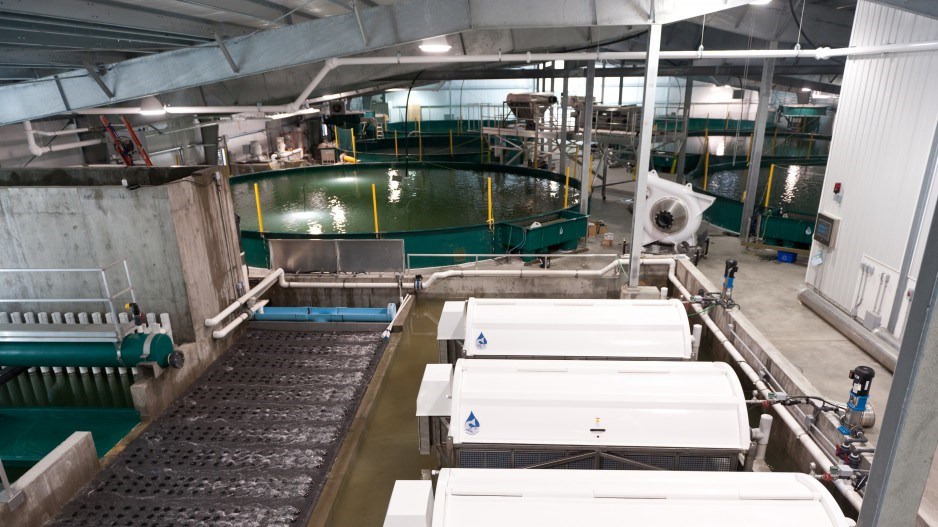Can land-based salmon farming ever be profitable in B.C. while competing with open-net fish farms?
Ross Beaty, one of B.C.’s most successful mining and renewable energy entrepreneurs, says it’s an open question, although he appears willing to take a risk that the answer is “Yes.”
He recently confirmed he is looking at one B.C.-based project, though he also confirmed it’s not Kuterra – the pioneering salmon farm owned by the Namgis First Nation near Port McNeill. The Namgis are looking to either divest ownership of the operation or attract the private investment needed to expand the project.
Meanwhile, a new group called BC LandAqua Ventures Inc., led by Kuterra chairman Eric Hobson, is trying to raise both private capital and government funding to develop an aquaculture park on Vancouver Island.
“Internationally it is happening,” Beaty recently told Business in Vancouver. “And it may happen that innovation and technology is going to get us there. Fish farming on land is established – it works. How we evolve that to B.C. with salmon is still an open question. But until you do it, you won’t know.”
International companies like Norway’s Atlantic Sapphire (OTCMKTS:AASZF) are planning investments in the hundreds of millions in new, large-scale closed-containment salmon farms in the U.S. – a signal that the market thinks there is a business case for them.
However, there may not be much of a business case for them in B.C., as long as they would have to compete with open-net salmon farms.
“Unless you have economic conditions that encourage it, it’s not going to happen,” Beaty said. “If you allow open-net pen aquaculture to not pay the real cost of their business – and the real cost is measured also in the reduction of the wild stocks – you’re never going to make change that’s going to be economic.”
Despite those provisos, Beaty said he has considered investing in closed-containment fish farming, and that he even considered investing in Kuterra at one point.
“They got to a certain scale, but it wasn’t the full scale they needed,” he said. “We were going to see if we could make it happen on more of a business level, but we never completed an agreement, so we’re not doing anything right now.
“But I would invest in some--thing, if it looked right, if it had the right sponsors, and in fact I am looking at one right now.”
Pressure has been mounting on the provincial government in recent weeks to end open-net fish farming and move to closed containment.
The Pacific Salmon Foundation, where Beaty sits on the board of directors, recently took a public stance, calling on senior governments to phase out open-net operations.
More recently, the British Columbia Government and Service Employees’ Union signed a declaration calling on the provincial government not to renew tenures that expired for fish farms in the Broughton Archipelago on June 20.
Companies owning those tenures have been given four years to get First Nations’ consent or risk having them cancelled.
A move to close down open-net operations would help make land-based fish farming more viable in B.C., since open-net aquaculture enjoys significantly lower capital and operating costs.
In a study that examined the viability of closed-containment fish farming in B.C., the Department of Fisheries and Oceans compared open-net aquaculture with eight types of closed containment and concluded that only one approach – recirculating aquaculture systems (RASes) – would be even marginally profitable. It calculated the capital cost of open-net aquaculture at $5 million, with a 52% return on investment in the third year, compared with $22.6 million for an RAS, with a return on investment of 4%. But that study was done in 2010, and, like wind turbines and solar panels, the costs of RASes have come down and the technology has improved.
“We were an experiment, and we believe we were a successful experiment,” said Kuterra spokeswoman Jo Mrozewski. “The world has shot ahead in those five years, whereas Kuterra used to be the leading edge and it’s not the leading edge anymore.”
Kuterra demonstrated that salmon could be successfully raised in closed-containment systems and that customers would pay a premium for the salmon it produced.
“One thing we have proven is that the market is strong,” Mrozew-ski said.
But Kuterra was built with a substantial amount of government funding. To succeed as a private enterprise, the operation would need to scale up. It currently produces about 300 tonnes of salmon per year.
Kuterra is set to produce its last harvest this month, then empty its grow-out tanks to perform maintenance. It will continue to raise juvenile salmon, and continues to seek out investors.
One advantage of the aquapark being proposed is that operators could share costs.
The principals behind the LandAqua project include Gary Robinson, an aquaculture professional specializing in RASes, Kuterra chairman Hobson and CEO Garry Ullstrom.
Hobson could not be reached for comment. But Mrozewski said the idea behind the project is to reduce capital costs by sharing land and infrastructure.
“There’s no question that, on the issue of land-based farming, scale is a key issue to control the capital cost,” she said. “One of the advantages of something like an aquapark is that you can have multiple entities sharing infrastructure and managing the margins.”
But if land-based aquaculture is as viable as proponents say it is, Stewart Muir, executive director of Resource Works, wonders why it would need government subsidies.
“If it’s such a great solution – and there are good arguments in favour of closed containment for certain things – then it should be able to stand on its own, both financially and without having to drag down its competition,” Muir said.




